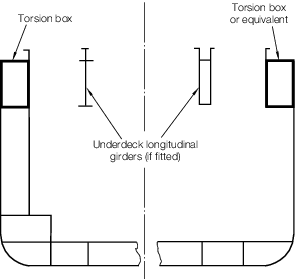
Section
1 General

1.1 Application and definitions
1.1.1 A container
ship is defined as a ship designed exclusively for the carriage
of containers in holds and on deck. Containers in holds are normally
stowed within cellular guide systems.
1.1.2 The
term ‘narrow side structures’ applies where the breadth
of hatch opening exceeds 90 per cent of the breadth of the ship.
1.1.3 Other
terms used to describe the various structural components of container
ships are generally indicated in Lloyd’s Register’s (hereinafter
referred to as ‘LR’) ShipRight FDA Procedure, Structural
Detail Design Guide.
1.1.4 Scantlings
and arrangements of container ships are to be as required by Pt 4, Ch 1 General Cargo Ships, except as otherwise indicated
in this Chapter.

Figure 8.1.1 Structural configuration

1.2 Structural configuration
1.2.1
Figure 8.1.1 Structural configuration shows the typical structural
configuration of a container ship covered by the requirements of this
Chapter. The typical configuration includes:
-
An efficient torsion
box girder or equivalent structure at the topsides comprising strength
deck, side shell, inner skin and a second deck. The space within the
torsion box is often utilised as an underdeck access passageway.
-
Single or double
skin side construction with or without bilge box.
-
Double bottom.
-
Continuous or
discontinuous hatch coamings.
-
Optional continuous
deck girders to support hatch covers.
1.2.2 For
container ships which do not conform to the above configuration, the
application of this Chapter will be specially considered

1.3 Class notations
1.3.1 In general,
ships complying with the requirements of this Chapter will be eligible
to be classed 100A1 Container Ship.
1.3.3 The ShipRight notations SDA (Structural Design Assessment) and
subsequently CM (Construction Monitoring) are mandatory for container ships with
a beam greater than 32,26 m or a length greater than 150 m or where the type, size and
structural configuration demand, including container ships with narrow side structures,
abnormal hull form or unusual structural configuration or complexity.
1.3.5 The
ShipRight notations SDA, FDA, FDA SPR, WDA may be applied
on a voluntary basis. In which case all the requirements of the relevant
procedures and supporting procedures are to be applied.

1.4 Information required
1.4.1 In addition
to the information and plans required by Pt 3, Ch 1, 5 Information required, the following are to be submitted:
-
Details of overlap arrangement of steps in decks and longitudinal
bulkheads.
-
Details of outline stowage arrangement of containers.
-
Details of design container stack weights.
-
Details of cell guides and supporting structure indicating the
position of guides relative to hatch corners, and attachment to structural
members.
-
Details of reinforcement to structure in way of container
corners/supports.
-
Details of reinforcement to structure in way of lashing bridges where
fitted.
-
Details showing the location of all openings in decks within the
cargo holds.
-
Details of longitudinal girders supporting hatch coamings where
fitted.
- Detailed arrangements for crack arrest design, see
Pt 4, Ch 8, 2.3 Requirements for use of thick steel plates.

1.5 Symbols and definitions
1.5.1 The
following symbols and definitions are applicable to this Chapter unless
otherwise stated:
L, L
pp, B, D, T, V, C
b as
defined in Pt 3, Ch 1, 6 Definitions
|
e
|
= |
base
of natural logarithms, 2,7183 |
|
s
|
= |
spacing
of secondary stiffeners, in mm |
|
s
1
|
= |
spacing of secondary stiffeners, but is not to be taken less
than 470 + 1,67L mm
|
|
t
|
= |
thickness
of plating, in mm |
|
L
1
|
= |
L but need not be taken greater than 190 m. |
|
| Copyright 2022 Clasifications Register Group Limited, International Maritime Organization, International Labour Organization or Maritime
and Coastguard Agency. All rights reserved. Clasifications Register Group Limited, its affiliates and subsidiaries and their respective
officers, employees or agents are, individually and collectively, referred to in this clause as 'Clasifications Register'. Clasifications
Register assumes no responsibility and shall not be liable to any person for any loss, damage or expense caused by reliance
on the information or advice in this document or howsoever provided, unless that person has signed a contract with the relevant
Clasifications Register entity for the provision of this information or advice and in that case any responsibility or liability is
exclusively on the terms and conditions set out in that contract.
|
 |
|